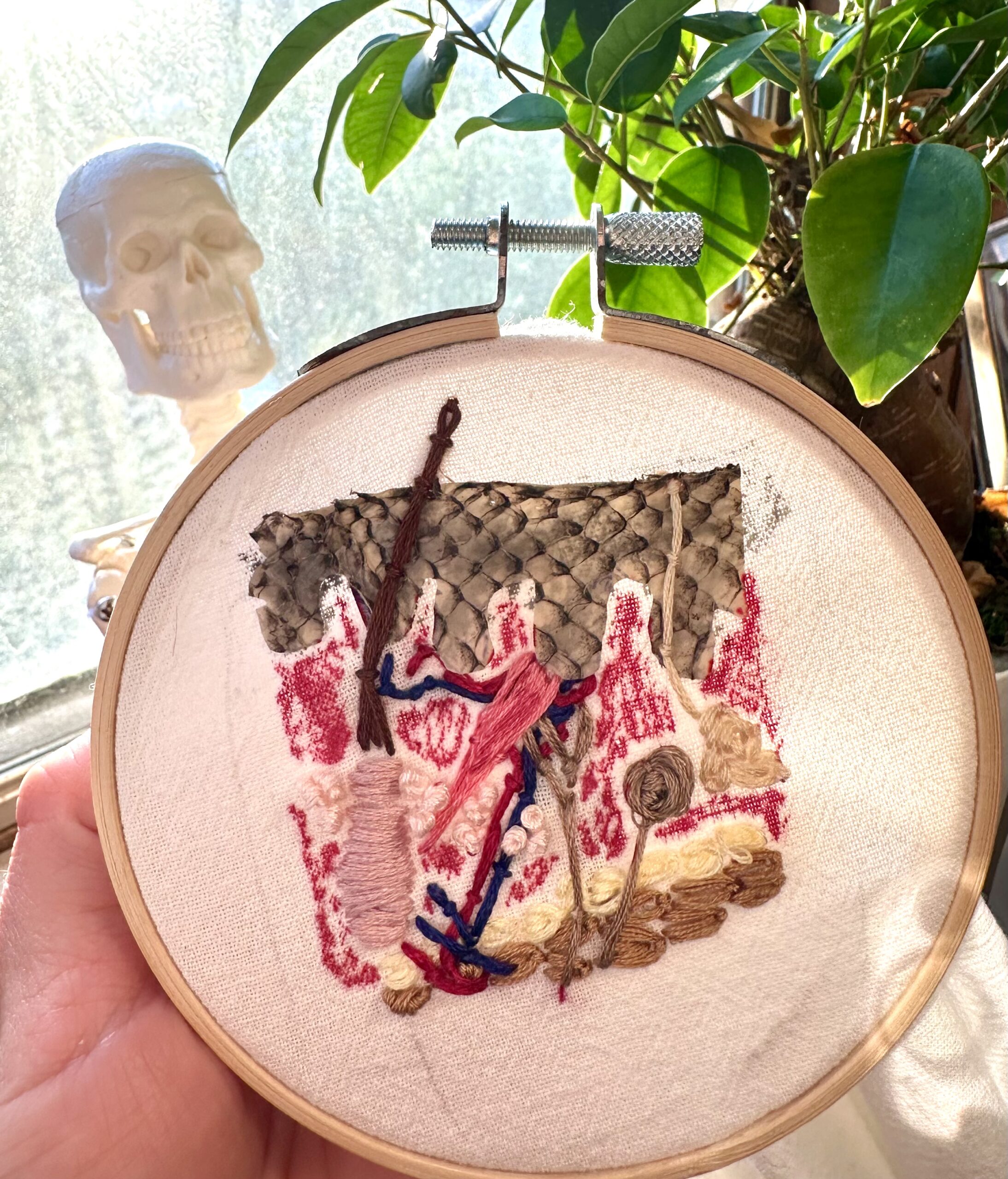The objective that this ties into is describing the functions of the integumentary system as well as the functions of the integumentary system. It also goes over the integumentary tissues and their functions as well.
My project highlights the layers of skin down to the fascia. The top layer, also known as the epidermis, is made of fish skin, I thought that would tie into the objective of this project by adding this layer. I originally wanted to use hide but that is thick and doesn’t have the texture I wanted. As you could imagine, if I depicted the infection, the skin would be black and airy, in the photos that I came across when the flesh-eating bacteria reaches the surface it would turn the skin black, and blisters (airy) would form. I had fun with the project using embroidery, it also helped me better understand, as I listened to the lecture videos while working on it.
I’ve always heard the phrase “your skin is the largest organ in your body,” but I never gave it much thought beyond the surface. Throughout this course, I’ve come to understand just how complex and vital our skin truly is. One of the things that skin does is, serves as a multi-layered barrier, protecting us from harmful elements like excessive sunlight and infections. Each layer of skin plays a unique role in maintaining our health and well-being. There is the epidermis, dermis, and the hypodermis.
What happens when this system is broken and there is harmful bacteria that gets in? I’d like to bring attention to an infection often discussed in the media as ‘flesh-eating bacteria,’ medically termed Necrotizing Fasciitis. It destroys the tissues one layer at a time and is very aggressive. This condition occurs when there’s a breach in the skin’s barrier, such as a wound, abrasion, bug bite, or surgical site. If the bacterium A Streptococcus, commonly involved, is present and manages to infiltrate the skin, it can lead to serious complications. Although it is rare, it affects not only in individuals with comorbidities like diabetes mellitus, immunodeficiency, or substance abuse issues but also healthy people as well. I’d like to focus on the aspect of this infection in those that have diabetes.
Diabetic patients can have a lot of complications related to wounds of their tissues and skin. This is because their blood sugar is high and it injures the nerves. Some wounds are not chronic and heal within a reasonable time and some might become chronic which do not heal quickly but seem to worsen if not treated right away. The wounds that are chronic must be treated as soon as possible and the only way to aid in healing and remove the wound is surgically. In surgery the wound undergoes debridement which is cutting out and washing out all the infected area and the necrotic tissue.
Necrotizing fasciitis affects the subcutaneous tissues and the fascia under the skin. It spreads rapidly to other layers of the skin, such as the muscles and can lead to amputation or death. There are other more common infections you might have heard of such as cellulitis. I think of the flesh-eating disease as a rapid spreading form of that. It is painful, there is redness, the patient will have fever as well as other symptoms. It is important to stop the spread to prevent sepsis and slow the spread.
https://docs.google.com/document/d/1Ha4qpAhyUL5DndQXLUPiZBT3u8IM_tM54EDHcxcvfIk/edit?usp=sharing
Diab, J., Bannan, A., & Pollitt, T. (2020). Necrotizing fasciitis. BMJ: British Medical Journal, 369, 1–6. https://www.jstor.org/stable/27237391
Hasham, S., Matteucci, P., Stanley, P. R. W., & Hart, N. B. (2005). Necrotising Fasciitis. BMJ: British Medical Journal, 330(7495), 830–833. http://www.jstor.org/stable/25459377
Rahim, K., Saleha, S., Zhu, X., Huo, L., Basit, A., & Franco, O. L. (2017). Bacterial Contribution in Chronicity of Wounds. Microbial Ecology, 73(3), 710–721. https://www.jstor.org/stable/48723304
Necrotising Fasciitis: Appearances Can Be Deceptive – PMC (nih.gov),
Reznicek, J., Perdue, P. W. J., & Bearman, G. (Eds.). (2020). Musculoskeletal infections : A clinical case book. Springer International Publishing AG.
DeBoer, S. L., Zeglin, D., & Kearney, K. (2001). Emergency: Necrotizing Fasciitis. The American Journal of Nursing, 101(4), 37–38. http://www.jstor.org/stable/3522658
Necrotizing Fasciitis: What is it
Shivalingappa S, Manjunath KN, Waiker V, Kumaraswamy M, Odeyar U. Necrotising Fasciitis: Appearances Can Be Deceptive. World J Plast Surg. 2021 Jan;10(1):43-52. doi: 10.29252/wjps.10.1.43. PMID: 33833953; PMCID: PMC8016375.



Brenda dove into the integumentary system for her STEAM project. She discussed the complexity of the layers of the skin as well as what happens when harmful bacteria gets in. For her project, she dove into what would happen to the skin if necrotizing fasciitis were to enter the skin barrier. She embroidered a model of the skin down to the fascia, which included the epidermis being made of fish skin in order to best interpret what the skin would look like while facing a flesh-eating bacterium: black and airy. I thought this was quite interesting as she made flesh-eating bacterium easier to understand.
When diving into said flesh-eating bacteria, she dove even deeper into a specific type: Necrotizing Fasciitis. This bacterium destroys the tissue one layer at a time and is quite aggressive. For a terrorizing condition like this to occur, the skin barrier has to be breached in ways such as a wound, abrasion, bug bite, surgical site, etc. states Brenda. The bacterium present is A Streptococcus. This bacterium is quite rare but can have complications such as diabetes, immunodeficiency, or substance abuse. This affects the subcutaneous tissues and the fascia under the skin and spreads rapidly to muscles, which can lead to amputation or death. I thought Brenda thoughtfully (and very nicely) explained a difficult topic! I enjoyed seeing her embroidery of the different aspects of skin, well done!